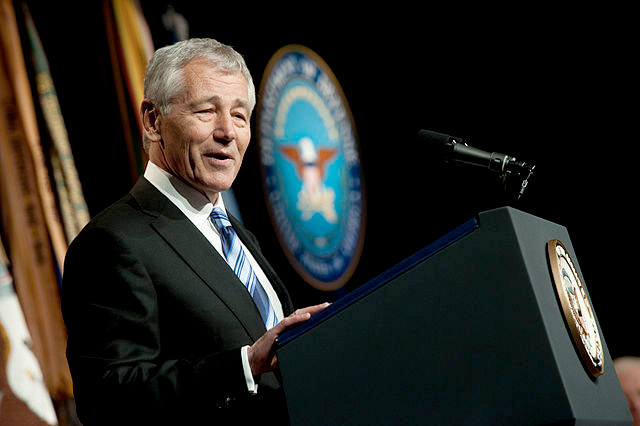The U.S. Defense Department (DoD) is launching a search for innovative technologies to help U.S. forces to maintain their advantage in the face of gains by potential adversaries, tighter budgets, and an increasingly complex landscape of security challenges.
At the top of the agency’s wish list are advances related to unmanned systems, including miniaturization and robotics as well as systems that can operate more autonomously.
The U.S. Defense Department (DoD) is launching a search for innovative technologies to help U.S. forces to maintain their advantage in the face of gains by potential adversaries, tighter budgets, and an increasingly complex landscape of security challenges.
At the top of the agency’s wish list are advances related to unmanned systems, including miniaturization and robotics as well as systems that can operate more autonomously.
“America does not believe in sending our troops into a fair fight,” Secretary of Defense Chuck Hagel said in a speech late Saturday (November 15, 2014) at the Reagan National Defense Forum in Simi Valley, California. “But that is a credo we will not be able to honor if we do not take the initiative and address these mounting challenges now. DoD must continue to modernize our nation’s capabilities and sustain its operational and technological edge.”
The Pentagon is establishing a Defense Innovation Initiative, he said, to “help identify, develop, and field breakthroughs in the most cutting-edge technologies and systems — especially from the fields of robotics, autonomous systems, miniaturization, big data, and advanced manufacturing, including 3D printing.”
Citing similar military efforts in the 1950s and 1970s to offset gains by other nations, Hagel told the audience he expected the new Long-Range Research and Development Planning Program would “develop into a game-changing third ‘offset’ strategy.”
His department was prepared to back up its plans with resources, Hagel said, and “new, long-term investments in innovation.” As the effort matures, he added, “I expect its impact on DoD’s budget to scale up in tandem.”
The program would “actively seek proposals from the private sector, including those firms, and from those firms and academic institutions outside DoD’s traditional orbit.”
Deputy Secretary of Defense Bob Work will guide the development of this initiative, said Hagel, as the head of a new Advanced Capability and Deterrent Panel. The panel will bring together DoD’s senior leadership, its policies and intelligence communities, the armed services, and the Joint Chiefs of Staff as well as key players in research, development, and acquisition.
“I expect the panel to propose important changes to the way DoD diagnoses and plans for challenges to our military’s competitive edge, and I also expected to break with many of our usual ways of doing business, encouraging fresh thinking that is focused on threats and challenges to our military superiority, not simply adapting what is on the books today.”
Looking for a Right to Rights
But the panel may need to tackle concerns over intellectual property (IP) if it wants to reach beyond the Pentagon’s usual contractor community for privately funded innovations.
There has been rising friction over IP rights between the Department of Defense and it suppliers as budgets have gotten tighter. Frustrated acquisition officials are pressuring contactors over IP provisions that do not allow the Pentagon to use competition to lower costs either for maintenance or through future procurements, National Defense magazine reported in January.
This fall Frank Kendall, DoD’s under secretary of defense acquisition, technology, and logistics underscored the need for taking IP into account in a September 14 policy paper.
“We need to do a better job of ensuring that our designs are modular — and that the government is in a position to control all the relevant interfaces so that competitors have the opportunity to win their way onto our programs,” he wrote in the paper Better Buying Power 3.0.
Those goals were front and center at the Program Review conference held by the Association for Unmanned Vehicle Systems International (AUVSI) November 4–6 in Virginia. DoD managers in charge of Navy, Air Force, and Army unmanned programs told an audience of defense contractors and entrepreneurs that they wanted to tap the private sector’s creativity — but that they also wanted flexibility and modularity so that they could, for example, easily add new sensors purchased separately.
Speaker Patrick Weldon, advanced programs product development manager at Polaris, expressed a willingness to work with the government — within limits. “I like what I see in the interface open (systems),” he said, “but don’t ask me to expose my proprietary CAN bus. I’ll give you an interface to it. I’ll let you access it. I’ll report back what your command was. But we’re not giving access to safety critical functions. That something I’m on the hook for in product liability.”
Assistant Secretary of Defense for Acquisition Katrina McFarland recently assured the audience at a Defense Daily conference in Washington that the Pentagon did not want to own a firm’s business secrets — though it did want to own the interfaces that would enable a system to be interoperable with another company’s technology down the road, FCW reported.
“There’s a lot of confusion related to intellectual property and open-systems architecture," she said. "There is no interest in the government in pursuing intellectual property when it’s the secret sauce of the company."




_and_Fergus_Noble_(R),_co-founde-e240cc279eaa83b2be814504fc94555b.jpg)

